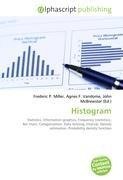
Histogram
High Quality Content by WIKIPEDIA articles! In statistics, a histogram is a graphical display of tabulated frequencies, shown as bars. It shows what proportion of cases fall into each of several categories: it is a form of data binning. The categories are... Viac o knihe
Produkt je dočasne nedostupný
30.80 €
bežná cena: 35.00 €
O knihe
High Quality Content by WIKIPEDIA articles! In statistics, a histogram is a graphical display of tabulated frequencies, shown as bars. It shows what proportion of cases fall into each of several categories: it is a form of data binning. The categories are usually specified as non-overlapping intervals of some variable. The categories (bars) must be adjacent. The intervals (or bands, or bins) are generally of the same size. Histograms are used to plot density of data, and often for density estimation: estimating the probability density function of the underlying variable. The total area of a histogram used for probability density is always normalized to 1. If the length of the intervals on the x -axis are all 1, then a histogram is identical to a relative frequency plot. An alternative to the histogram is kernel density estimation, which uses a kernel to smooth samples. This will construct a smooth probability density function, which will in general more accurately reflect the underlying variable. The histogram is one of the seven basic tools of quality control, which also include the Pareto chart, check sheet, control chart, cause-and-effect diagram, flowchart, and scatter diagram.
- Vydavateľstvo: Alphascript Publishing
- Formát: Paperback
- Jazyk:
- ISBN: 9786130250188


 Anglický jazyk
Anglický jazyk 









